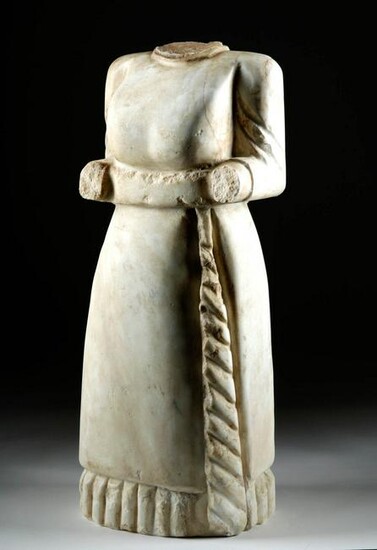Roman Marble Statue - Woman in Stola
Roman, Imperial Period, ca. 1st to 4th century CE. Carved from a large, solid piece of beautiful, creamy marble, this is a tomb attendant figure, depicting a woman's body dressed in a stola. The carving gives an exceptional view of a piece of clothing that is often hidden by a gauzy, draped himation in artwork, and also gives us important clues as to the identity of the woman depicted in the statue. The flounce on the long side of the skirt and the bottom, the high waist held in place by a thick belt, and the gathered sleeves are all nicely carved here. The rest of the marble surface is beautifully smooth. The hands probably once held items - a fan, maybe, or a mirror - while the head likely had a detailed and ornate coiffure. This figure probably graced a tomb, serving as an attendant and mourner. Size: 6" L x 9" W x 22" H (15.2 cm x 22.9 cm x 55.9 cm)
Stolae were made of linen or wool, although the wealthiest women could wear ones made of silk. They came in a variety of colors - reds, yellows, and blues - and often had decoration on the neckline and hem, like the flounce seen here. Roman women had to adhere to strict rules about clothing. A woman could only dress in the stola after her marriage (in fact, courtesans could only wear men's togas!), and they were an outward sign of the wealth and prestige associated in the Roman world with being a married woman.
Provenance: ex-private East Coast collection, New York, USA; ex-East Coast collection, New York Gallery, New York City, New York, USA, acquired before 2010
All items legal to buy/sell under U.S. Statute covering cultural patrimony Code 2600, CHAPTER 14, and are guaranteed to be as described or your money back.
A Certificate of Authenticity will accompany all winning bids.
PLEASE NOTE: Due to recent increases of shipments being seized by Australian & German customs (even for items with pre-UNESCO provenance), we will no longer ship most antiquities and ancient Chinese art to Australia & Germany. For categories of items that are acceptable to ship to Australia or Germany, please contact us directly or work with your local customs brokerage firm.
Display stands not described as included/custom in the item description are for photography purposes only and will not be included with the item upon shipping.
#141481
Condition Report: Head and hands are lost. Surface wear commensurate with age, with scratching and chips, especially around where the hands used to be and down the fringe of the garment. Nice deposits on surface and good preservation of remaining form.
View it on
Estimate
Time, Location
Auction House
Roman, Imperial Period, ca. 1st to 4th century CE. Carved from a large, solid piece of beautiful, creamy marble, this is a tomb attendant figure, depicting a woman's body dressed in a stola. The carving gives an exceptional view of a piece of clothing that is often hidden by a gauzy, draped himation in artwork, and also gives us important clues as to the identity of the woman depicted in the statue. The flounce on the long side of the skirt and the bottom, the high waist held in place by a thick belt, and the gathered sleeves are all nicely carved here. The rest of the marble surface is beautifully smooth. The hands probably once held items - a fan, maybe, or a mirror - while the head likely had a detailed and ornate coiffure. This figure probably graced a tomb, serving as an attendant and mourner. Size: 6" L x 9" W x 22" H (15.2 cm x 22.9 cm x 55.9 cm)
Stolae were made of linen or wool, although the wealthiest women could wear ones made of silk. They came in a variety of colors - reds, yellows, and blues - and often had decoration on the neckline and hem, like the flounce seen here. Roman women had to adhere to strict rules about clothing. A woman could only dress in the stola after her marriage (in fact, courtesans could only wear men's togas!), and they were an outward sign of the wealth and prestige associated in the Roman world with being a married woman.
Provenance: ex-private East Coast collection, New York, USA; ex-East Coast collection, New York Gallery, New York City, New York, USA, acquired before 2010
All items legal to buy/sell under U.S. Statute covering cultural patrimony Code 2600, CHAPTER 14, and are guaranteed to be as described or your money back.
A Certificate of Authenticity will accompany all winning bids.
PLEASE NOTE: Due to recent increases of shipments being seized by Australian & German customs (even for items with pre-UNESCO provenance), we will no longer ship most antiquities and ancient Chinese art to Australia & Germany. For categories of items that are acceptable to ship to Australia or Germany, please contact us directly or work with your local customs brokerage firm.
Display stands not described as included/custom in the item description are for photography purposes only and will not be included with the item upon shipping.
#141481
Condition Report: Head and hands are lost. Surface wear commensurate with age, with scratching and chips, especially around where the hands used to be and down the fringe of the garment. Nice deposits on surface and good preservation of remaining form.





